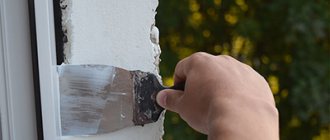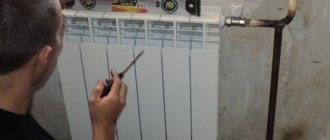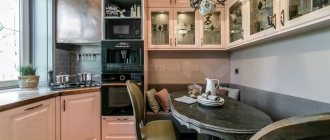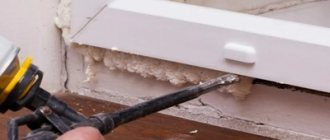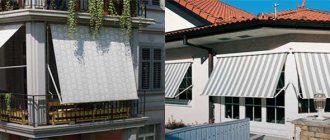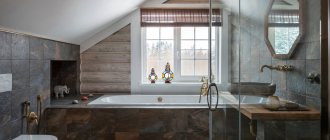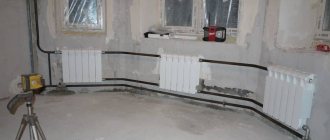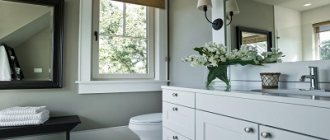The external seam on windows is sealed using different materials. But there are materials that are not intended for outdoor use. What materials should be used to seal the external seam, and why do it? Read in this article.
Let's start by defining the outer seam. I divide the outer seam into two types:
- In the quarter opening. The external seam is the gap between the window and the quarter of the window opening on the street side (top photo).
- In a quarterless doorway. The external seam is the gap between the window and the window opening on the street side.
How to cover the polyurethane foam?
Polyurethane foam is a building material with excellent thermal insulation properties and good moisture resistance. It is often used when installing window structures; it is used to seal the seams between the frame and the window opening.
Exposure to moisture, ultraviolet radiation and temperature changes can destroy the material within a few years. This is especially true for external seams. Treatment of polyurethane foam with special materials will significantly increase the service life of polyurethane foam:
Acrylate paint.
Facade sealant.
The putty is resistant to sub-zero temperatures.
Liquid plastic.
Window mask.
The simplest and cheapest method to protect polyurethane foam is to cover it with a layer of ordinary mortar made of cement and sand. Before covering, use PSUL tape - it will make the protection even more reliable.
Seams should be sealed on both the outside and inside of the room. This must be done immediately after installing the double-glazed window.
Sealing between sashes and frame
Gaps formed between the frame and window sashes appear due to wear or defects in the rubber seal. To plug the cracks, you need to replace it with a wooden spatula.
This requires:
- Carefully remove the worn seal from the grooves in the frame.
- Vacuum the remaining gaps and go over inside and outside with a damp cloth.
- Insert the new rubber seal tightly into the groove with a wooden spatula.
- To increase service life, treat once a year with a silicone-based spray, which will prevent the material from drying out.
What to do with cracks under the windowsill?
The cause of blowing under the window sill may be subsidence of the window structure, errors during its installation or degradation of the thermal insulation layer.
The problem of depressurization can be solved by using plaster or a shock portion of polyurethane foam from inside the room or from the street. The “outdoor” option is preferable, but it is not suitable for winter. When sealing the gap under the window sill from inside the room, proceed according to the following algorithm:
- Cut off the wallpaper at the work site.
- Unstitch the seam under the window to its maximum length and width.
- Fill the joint with plaster or foam.
- After the foam has cured, trim off any excess foam and cover it with putty or sealant.
- Cover the repair area with wallpaper.
You can fix the problem in 2-3 hours, even if you have no experience in repair work. But it’s better not to let things get too cold and carefully check the tightness of the structure in the summer. Sealing the seams from the street and inside the apartment is guaranteed to save you from an unpleasant draft under the window sill. After blowing in foam, be sure to cover it with plaster or sealant.
Sometimes a draft appears not under, but above the window sill. This problem can also be fixed from the inside or outside. In the latter case, you need to foam the seam that is under the low tide.
This method is effective, but it does not work at sub-zero temperatures. In this case, you should buy a sealant and carefully coat the joint between the frame and the window sill with it.
Efficiency of use
Liquid plastic, the instructions for which are not always read by users, will not cause difficulties in use. Before applying the glue, the surfaces are free of all kinds of dirt and dust. Then, the surfaces are thoroughly dried. The entire gluing result depends on the quality of preparation. Liquid glue is applied extremely carefully, in a smooth layer over the entire joint. After 15 minutes, the glue dries and becomes hard.
It is important to know that when liquid plastic hardens, it decreases in volume and the seam will become more retracted.
Main characteristics of Cosmofen sealant:
- the optimal temperature ranges from +20 to +5 degrees;
- It will take 5 minutes for the glue to harden, while it will take a little more than a day to completely harden;
- to achieve optimal results, the air humidity in the workroom must be at least 60%;
- the properties of liquid plastic are maintained for a couple of minutes after applying the mass to the work surface;
- It is customary to consume cosmofen liquid plastic in a ratio of 150g/m2.
Cosmofen plus is used for installation work: sewerage, plumbing, outdoor advertising and aluminum structures of any complexity.
- accelerated polymerization;
- resistance to sudden temperature changes;
- increased resistance of the material to ultraviolet rays.
Technical features and characteristics:
- the polymer base of the glue is located directly in the solvent;
- impact-viscous property of the adhesive in the solid state;
- the optimal operating temperature in the workroom will be +5 degrees Celsius;
- A few minutes are enough for strong bonding. A better effect can be achieved with additional load;
- The glue will completely harden within 24 hours.
How to seal the slopes?
Installing a double-glazed window usually leads to a violation of the integrity of the window opening. Therefore, slopes are the final stage of installation of window structures.
Slopes perform not only decorative functions. They protect structures from condensation and foam from degradation. Their restoration should not be delayed, but carried out immediately after the installation of the double-glazed window is completed.
There are three finishing options:
- drywall;
- plaster;
- plastic panels.
Each of these materials has its own advantages and disadvantages.
Drywall
This is an inexpensive and practical material that allows you to level even complex surfaces. Its disadvantages include low strength and fear of moisture. The latter property makes it impossible to use drywall for finishing external surfaces. But even when carrying out interior work, it is better to cover this material with a primer or other moisture-resistant materials.
There are several ways to install drywall sheets:
- on a wooden or metal sheathing;
- on the corners;
- using glue.
Today the most popular installation of plasterboard sheets on the corner. It allows you not only to give the opening an attractive appearance, but also additionally insulates the window. Drywall is covered with several layers of plaster, rubbed down and painted in the desired color.
Plaster
The traditional way to seal slopes is to cover them with plaster. It is cheap and simple, but at the same time quite labor-intensive and time-consuming.
For working with internal surfaces, both cement and gypsum mixtures are well suited; for external surfaces, it is necessary to use facade compositions or ordinary sand-cement plaster.
First you need to carefully prepare the surface: remove old plaster, dust, and excess foam. To increase adhesion, it is better to apply notches to the walls and coat them with a primer. The corners of the opening are reinforced with a perforated corner. It is advisable to cover the glass unit with film - this will protect it from contamination.
When sealing external slopes, it is advisable to use reinforcing mesh.
After leveling the plaster, it is primed and painted.
Plastic slopes
Slopes made of PVC panels are durable, practical and hygienic. It is quite possible to install them literally in a day - you do not need to wait for the layers of plaster to dry.
However, the appearance of these panels is unique - many believe that such material is only suitable for public spaces. Plastic looks fine in the kitchen, but for the bedroom or living room it is better to choose something else.
PVC panels are attached to the profile, covering the joints with special decorative corners. Mineral wool is placed in the empty space for insulation.
Plastic panels are rarely used for outdoor work, because this material tolerates sunlight and low temperatures very poorly.
Decorative rock
Decorative stone made from gypsum and cement is used to finish slopes. Outwardly, it is no different from natural, but at the same time it is much lighter and cheaper than the latter.
Decorative stone is strong and can withstand high humidity and temperature changes. It can also be used to decorate external surfaces. The advantage of the material is its “rich” appearance and a wide variety of colors.
Finishing slopes with decorative stone is simple:
- The stone is placed on glue, which is applied using a comb or spatula.
- When working with a flat surface, you can do without preliminary preparation. If there are defects, then it is better to plaster the slopes.
- If there are seams between the stones, then you need to use crosses, as when laying tiles.
- When installing elements of arbitrary shape, they must be laid out on a horizontal surface in advance. To trim the stone, use a hacksaw or grinder.
To increase service life, the material can be coated with a protective compound.
Liquid plastic for PVC windows: rationality of its use
Liquid plastic for windows, in the usual understanding of the average person, is a special sealant that is used to treat window joints and seams.
Advantages
Liquid plastic has recently appeared on the market and has virtually no disadvantages. This sealant uses the principle of diffuse welding, that is, it has the property of ideally welding surfaces in places where parts come into contact. Consequently, after applying the glue, a single part is formed in the problem area, without any color or other modifications.
Butt window treatment using liquid plastic has the following positive properties:
- joining seams are treated with the same material as is used for slopes and windows;
- high density of parts bonding;
- after complete hardening, a monolithic part is formed at the gluing (welding) site, where there will be absolutely no gaps between the slope part and the window;
- the desired effect is achieved through the use of diffuse welding - a technology that provides for the mutual penetration of parts;
- mold or mildew will never form in the place where the treatment was carried out, and the seam itself is characterized by sufficient strength;
- the sealant is absolutely safe for health and does not harm the environment;
- The manufacturer's stated warranty regarding the sealant indicates that the formed seam will not be subject to change for at least 15 years.
Price
For a 200 g tube only 275 rubles. You can buy it at any hardware store.
Sealing the seams of plastic windows with liquid plastic
The practice of using and applying cosmophene is not complicated.
The technology for working with the composition is carried out in the following sequence:
- the two surfaces to be joined must first be cleaned from traces of dirt and dust, dried securely and degreased using lint-free wipes;
- for a perfect invisible seam, it is better to use masking tape so that the seam is perfectly even;
- open the tube, apply an even strip of adhesive throughout the entire damaged and pre-treated area;
There is no need to smear or rub liquid plastic into the seam!
- Stable drying of the sealant occurs within 15 minutes.
Review of window cleaning devices
When you start working with liquid plastic, it is worth noting that:
- the consistency of the sealant can remain liquid only for the first two minutes;
- the best temperature in the room for work is an environment in the range from + 5 to + 20 degrees;
- the optimal humidity level for effective work with glue is 60%;
- rational glue consumption is noted in the range of 150 g/m2;
- the optimal rigidity of the applied adhesive is formed already in 4 minutes;
- glue is flammable, but only at temperatures exceeding 300 degrees;
- The full stage of hardening occurs after one day.
To remove glue residue from a metal surface, you should use a special cleaner.
If traces of liquid plastic have formed on the surface of a solid PVC profile, then you should wait for it to completely harden. Armed with a sharp blade, cut off the protruding part of the glue, and then treat the remaining sealant with a special cleaner.
External slopes: what are they for?
The finishing of external slopes should not be postponed, as they protect the thermal insulation layer from degradation, and structural elements from environmental influences.
Proper preparation of the outer part of the opening significantly increases the sound and heat insulation properties of the double-glazed window. In addition, it will make your home much more attractive from the outside.
Most often, plaster or various facade mixtures are used for such work. It is recommended to lay them in several layers, and the previous one must dry normally before applying a new layer.
After the last layer has dried, it needs to be painted - this will provide additional protection from moisture and temperature.
Sealing technology
To carry out high-quality sealing of window seams, it is necessary to strictly follow the sequence of operations during installation work.
Sealing gaps between slopes
- Along the boundaries of the gap between the window slopes, you should stick masking tape to prevent the sealant from getting on the slopes.
- The seam is filled with sealant so that its excess protrudes above the slope by 1 - 2 cm.
- Then, the sealant is pressed into the seam with a narrow spatula, sponge or simply a moistened finger.
- The masking tape and remaining sealant are removed.
Sealing cracks in window frames
- For better aesthetic perception, the color of the sealant should match the color of the window panels.
- Before carrying out work, you need to prepare the necessary tools and accessories: a gun for applying sealant, 2 small spatulas, a container with water and a sponge.
- The joints are pre-cleaned and degreased.
- The sealant is applied to a spatula and then placed into the window slot using transverse movements.
- After installation, the sealant in the seam is leveled with longitudinal movements of the spatula.
- Upon completion of installation, excess sealant is removed with a damp sponge.
Announcements on NN.RU – Construction
Designed for storing Foolscap/A4 format documents in hanging files (each document separately), or in folders like. Price: 11,475 rub.
The metal cabinet for tools ШИ-4П has a rigid welded structure, the frame of the cabinet is welded from a square profile pipe. Price: 15,522 rub.
The bench cabinet TSN-1 has an all-welded design. The tabletop consists of moisture-resistant plywood 24 mm thick and a sheet of metal 1. Price: RUB 5,678.
The cabinet is powder coated in light gray. Supplied assembled. Price: 91,382 rub.
If you heard Dmitry Bykov on the radio, read his columns, books, articles, came to lectures, you do not know him. He is a poet.
Source: www.nn.ru
Average prices in the Russian Federation
You can purchase connectors for PVC windows both in a construction hypermarket, store, and in special companies that install plastic windows.
The average cost of products across the country varies:
- “noodle” type - from 150 rubles per linear meter;
- “bone” type - from 400 rubles per 1.5 meters.
The cost of the device will vary depending on the region of sale, manufacturer, material and thickness.
Connecting (docking) profiles 70 series
Analog KBE Art No. 350
Type of additional profile: Connecting profile, in a pallet - 1950 linear meters
Analogue KBE Art No. 340
Type of additional profile: Connecting profile, 70 series, in a pallet - 208 linear meters
Analog KBE Art No. 341
Type of additional profile: Universal connector adapter, 70 series, in a pallet - 208 linear meters
Analog KBE Art No. 352
Type of additional profile: Connecting H-shaped, 70 series, in a pallet - 455 linear meters
Analog KBE Art No. 355
Type of additional profile: Corner connector 90, in a pallet - 273 linear meters
What types of plastic window connectors are there?
You need to know what system your plastic window is, since each manufacturer has different types of connections and can differ greatly from each other. Even windows from the same manufacturer can have different types of connections. So, for example, window profiles produced under the GOODWIN brand have at least two of the most common window systems, such as group 583 and group 705
In each group, the profiles are different from each other, although they have the same names. They differ in their article numbers, which consist of four numbers. Below are the profiles themselves and their components, including fasteners.
Source: restart24.ru
Connecting (docking) profiles 58 series
Analog KBE Art No. 150
Type of additional profile: Connecting profile, in a pallet - 2080 linear meters
Analog KBE Art No. 540
Type of additional profile: Connecting profile, 58 series, in a pallet - 208 linear meters
Analog KBE Art No. 541
Type of additional profile: Universal connector adapter, 58 series, in a pallet - 208 linear meters
Analog KBE Art No. 152
Type of additional profile: H-shaped connector, 58 series, in a pallet - 455 linear meters
Analog KBE Art No. 155
Type of additional profile: Corner connector 90, in a pallet - 273 linear meters
